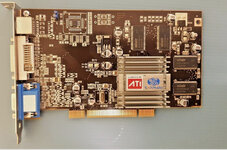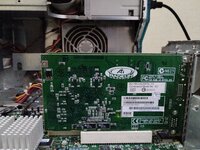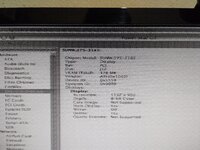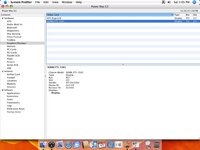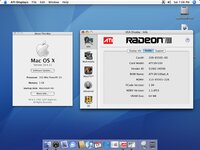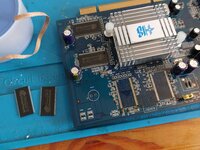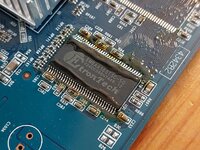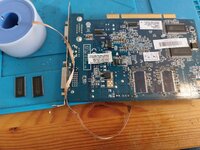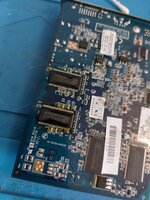I thought that the LE was the 'Lite Edition' but the specs do look identical. Maybe it means 'Limited Edition'.
I can't help you but I do have more info.
Have a look at the comparison in the techpowerup.com chart:
https://www.techpowerup.com/gpu-specs/?generation=Radeon R200&sort=name
GPU Memory Shaders /
Card GPU Memory Clock Clock TMUs / ROPs
Radeon 7500 RV200 32 MB, DDR, 128 bit 260 MHz 180 MHz 2 / 1 / 6 / 2 Mac Edition
Radeon 9000 RV250 64 MB, DDR, 128 bit 250 MHz 200 MHz 4 / 1 / 4 / 4 PCI version. The AGP Pros are 275/275MHz.
Radeon 9200 RV280 64 MB, DDR, 128 bit 250 MHz 200 MHz 4 / 1 / 4 / 4
Radeon 9200SE RV280 64 MB, DDR, 128 bit 200 MHz 166 MHz 4 / 1 / 4 / 4
Radeon 9200LE RV280 64 MB, DDR, 128 bit 250 MHz 200 MHz 4 / 1 / 4 / 4
Radeon 9250 RV280 128 MB, DDR, 128 bit 240 MHz 200 MHz 4 / 1 / 4 / 4
To be fair, 128MB of VRAM on a Mac OS 9 machine is waaaay too much and any of the cards will do for Mac OS 9 gaming.
Mac OS X is surely a very different beast and I know much too little about to be able to comment on it.
TI Radeon 9200 LE
ATI RV280, 250 MHz, 4 Pixel Shaders, 1 Vertex Shaders, 4 TMUs, 4 ROPs, 64 MB DDR, 200 MHz, 128 bit

www.techpowerup.com
The Radeon 9200 LE was a graphics card by ATI, launched on May 1st, 2003. Built on the 150 nm process, and based on the RV280 graphics processor, the card supports DirectX 8.1. Since Radeon 9200 LE does not support DirectX 11 or DirectX 12, it might not be able to run all the latest games. The RV280 graphics processor is a relatively small chip with a die area of only 98 mm² and 36 million transistors. It features 4 pixel shaders and 1 vertex shader 4 texture mapping units, and 4 ROPs. Due to the lack of unified shaders you will not be able to run recent games at all (which require unified shader/DX10+ support). ATI has paired 64 MB DDR memory with the Radeon 9200 LE, which are connected using a 128-bit memory interface. The GPU is operating at a frequency of 250 MHz, memory is running at 200 MHz.
Being a single-slot card, the ATI Radeon 9200 LE draws power from 1x Molex power connector, with power draw rated at 28 W maximum. Display outputs include: 1x DVI, 1x VGA, 1x S-Video. Radeon 9200 LE is connected to the rest of the system using an AGP 8x interface.
ATI Radeon 9200
ATI RV280, 250 MHz, 4 Pixel Shaders, 1 Vertex Shaders, 4 TMUs, 4 ROPs, 128 MB DDR, 200 MHz, 128 bit

www.techpowerup.com
The Radeon 9200 was a graphics card by ATI, launched on May 1st, 2003. Built on the 150 nm process, and based on the RV280 graphics processor, in its RV280 9200 variant, the card supports DirectX 8.1. Since Radeon 9200 does not support DirectX 11 or DirectX 12, it might not be able to run all the latest games. The RV280 graphics processor is a relatively small chip with a die area of only 98 mm² and 36 million transistors. It features 4 pixel shaders and 1 vertex shader 4 texture mapping units, and 4 ROPs. Due to the lack of unified shaders you will not be able to run recent games at all (which require unified shader/DX10+ support). ATI has paired 128 MB DDR memory with the Radeon 9200, which are connected using a 128-bit memory interface. The GPU is operating at a frequency of 250 MHz, memory is running at 200 MHz.
Being a single-slot card, the ATI Radeon 9200 does not require any additional power connector, its power draw is rated at 28 W maximum. Display outputs include: 1x DVI, 1x VGA, 1x S-Video. Radeon 9200 is connected to the rest of the system using an AGP 8x interface.



